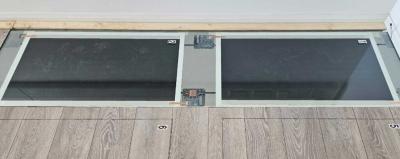Graphene thermal conductivity - introduction and latest news
Graphene thermal conductivity
Thermal transport in graphene is a thriving area of research, thanks to graphene's extraordinary heat conductivity properties and its potential for use in thermal management applications.
The measured thermal conductivity of graphene is in the range 3000 - 5000 W/mK at room temperature, an exceptional figure compared with the thermal conductivity of pyrolytic graphite of approximately 2000 W/mK at room temperature. There are, however, other researches that estimate that this number is exaggerated, and that the in-plane thermal conductivity of graphene at room temperature is about 2000-4000 W/mK for freely suspended samples. This number is still among the highest of any known material.
Graphene is considered an excellent heat conductor, and several studies have found it to have unlimited potential for heat conduction based on the size of the sample, contradicting the law of thermal conduction (Fourier's law) in the micrometer scale. In both computer simulations and experiments, the researchers found that the larger the segment of graphene, the more heat it could transfer. Theoretically, graphene could absorb an unlimited amount of heat.
The thermal conductivity increases logarithmically, and researchers believe that this might be due to the stable bonding pattern as well as being a 2D material. As graphene is considerably more resistant to tearing than steel and is also lightweight and flexible, its conductivity could have some attractive real-world applications.
But what exactly is thermal conductivity?
Heat conduction (or thermal conduction) is the movement of heat from one object to another, that has a different temperature, through physical contact. Heat can be transferred in three ways: conduction, convection and radiation. Heat conduction is very common and can easily be found in our everyday activities - like warming a person,s hand on a hot-water bottle, and more. Heat flows from the object with the higher temperature to the colder one.
Thermal transfer takes place at the molecular level, when heat energy is absorbed by a surface and causes microscopic collisions of particles and movement of electrons within that body. In the process, they collide with each other and transfer the energy to their neighbor, a process that will go on as long as heat is being added.
The process of heat conduction mainly depends on the temperature gradient (the temperature difference between the bodies), the path length and the properties of the materials involved. Not all substances are good heat conductors - metals, for example, are considered good conductors as they quickly transfer heat, but materials like wood or paper are viewed as poor conductors of heat. Materials that are poor conductors of heat are referred to as insulators.
How can graphene,s exciting thermal conduction properties be put to use?
Some of the potential applications for graphene-enabled thermal management include electronics, which could greatly benefit from graphene's ability to dissipate heat and optimize electronic function. In micro- and nano-electronics, heat is often a limiting factor for smaller and more efficient components. Therefore, graphene and similar materials with exceptional thermal conductivity may hold an enormous potential for this kind of applications.
Graphene's heat conductivity can be used in many ways, including thermal interface materials (TIM), heat spreaders, thermal greases (thin layers usually between a heat source such as a microprocessor and a heat sink), graphene-based nanocomposites, and more.
Graphene Manufacturing Group updates on THERMAL-XR commercialization progress
Graphene Manufacturing Group (GMG) has provided a commercialization update on its THERMAL-XR Powered by GMG Graphene technology, highlighting ongoing customer engagements, testing, and industry recognition.
At a recent event in Brisbane, GMG re-launched its product, now branded as THERMAL-XR ENHANCE, which boasts improved heat transfer and corrosion protection capabilities. In a statement, GMG said that the rebranding from THERMAL-XR RESTORE reflects the product's expanded applications, including enhancing heat transfer in new HVAC equipment, a capability reportedly confirmed through third-party verification.
DUER launches graphene-enhanced jacket
DUER, an innovative denim company, has launched its new Performance Flannel that is enhanced with graphene. The fabric is said to regulate body temperature without feeling heavy, fight static and stay fresh longer.
“Graphene caught our attention as a Nobel prize-winning nano-fiber with exceptional performance properties that don’t impact a fabric’s weight, breathability, or soft feel,” said Gary Lennett, CEO of DUER. “We’ve integrated graphene into our Performance Flannel to provide enhanced thermal regulation— keeping you warm when it’s cold, and cool when it’s hot. Added to that, it fights static and keeps clothing fresh longer, marking a significant step in the future of textiles.”
Carbon Waters opens its first production unit
Carbon Waters has announced a major milestone with the installation of its first production unit at its facility in Pessac.
Since its inception, Carbon Waters been active in the field of graphene-based performance additives. In 2022, it launched the recurring production of high-performance and ready-to-use additive range, Graph‘Up. These additives are dedicated to anticorrosion paints, mechanical reinforcement, and thermal property optimization of polymers and composites. Summer 2024 marked the arrival of Carbon Waters' first production unit. This investment helps Carbon Waters to multiply its production capacity by fifteen, a major step forward in meeting growing industrial demand.
Xiaomi launches a graphene radiator capable of heating a room in a few seconds
Xiaomi has released its new Xiaomi Mijia Graphene Skirting Board Heater 2, a graphene radiator that boasts a powerful heating system 2.200W and a foldable format. The Xiaomi Mijia Graphene Skirting Board Heater 2 features a graphene heating technology heater capable of providing heat in just 3 seconds and heating an entire room to the desired temperature in just 15 minutes.
In 2022, Xiaomi launched the Mijia Graphene Baseboard Heater (Fire Edition). The device uses two graphene-based heating elements, and has a simulated flame function that uses an integrated humidifier and LEDs to generate the flame appearance. This new launch seems to be the next generation in the same product line.
Haydale and Jersey Energy Technologies announce underfloor heating pilot in Jersey
Haydale has announced that it has signed a contract with Jersey Energy Technologies ("JET"), a start-up company focused on providing energy efficiency solutions across the Channel Islands, to begin a pilot trial deploying Haydale's underfloor heaters within social housing in Jersey.
Haydale's underfloor heating system utilizes the Company's proprietary HDPlas functionalization technology to unlock the high-level thermal conductivity properties of graphene. Data gathered from Haydale's in-house prototype systems implies up to 30% lower operating cost for their functionalized graphene ink underfloor heating compared to standard wired systems running off mains power. In test conditions, the heaters, which can be uniformly and individually heated, have also shown improvements in flexibility, and durability; reaching maximum temperatures quickly. This presents a potential commercial solution to meet the demand for improved energy efficiency, reducing heating costs for residents without trade off.
Researchers develop scalable graphene technology for regulating heat transfer and enhancing battery safety
Researchers at Swansea University, in collaboration with China's Wuhan University of Technology and Shenzhen University, have developed a technique for producing large-scale graphene current collectors that could significantly enhance the safety and performance of lithium-ion batteries (LIBs).
Their recent study details the first successful protocol for fabricating defect-free graphene foils on a commercial scale. These foils offer excellent thermal conductivity - nearly ten times higher than traditional copper and aluminium current collectors used in LIBs.
Salgenx expands potential applications of its graphene and hard carbon-coated sand
Salgenx, developer of saltwater flow battery technology, has announced the expansion of its development of graphene and hard carbon-coated sand. Originally designed for use in advanced battery systems, Salgenx is now exploring a wide array of new applications for this innovative material, ranging from smart infrastructure to environmental sustainability.
The Company says that "the unique combination of graphene and hard carbon in a sand aggregate has the potential to transform the construction industry". By enhancing the electrical conductivity, mechanical strength, and durability of concrete, Salgenx’s carbon-coated sand opens up new possibilities in building and infrastructure development.
Haydale Graphene Industries and Staircraft report progress on graphene-based underfloor heating trials
Specialist structural flooring manufacturers Staircraft have been testing the use of Haydale's graphene-based functional ink for application on their innovative chipboard flooring system. Significant investment has reportedly been made to get the new flooring system to adopt a heating solution that is cost effective and easy to install.
In a recent trial, Staircraft has reported very encouraging results and is now focused on continuing to collect definitive data before introducing the concept to their customer base.
Graphene Composites USA selected to join U.S Military footwear project
Graphene Composites USA (GC) has been selected to participate in a research and development program between DEVCOM Soldier Center, Natick MA and UMass Lowell, to develop materials for the next generation of U.S. military footwear.
The program, SWIFT [Supporting Warfighters through Innovative Footwear Technologies], is offered by the HEROES (Harnessing Emerging Research Opportunities to Empower Soldiers) initiative and will see GC extend its patented GC Composite graphene and aerogel technology to develop ultra-lightweight, durable, insulative materials for use in extreme cold weather.
Researchers develop new approach for controlling thermal emission
Researchers from the University of Manchester, The Pennsylvania State University, Koç University and Vienna University of Technology (TU Wien) have tackled the challenge of control of thermal radiation, demonstrating a new topology-based approach.
The team explained that conventional approaches to tailoring thermal emission using metamaterials are hampered both by the limited spatial resolution of the required subwavelength material structures and by the materials’ strong absorption in the infrared. In their recent work, the scientists developed an approach based on the concept of topology: by changing a single parameter of a multilayer coating, they were able to control the reflection topology of a surface, with the critical point of zero reflection being topologically protected.
Pagination
- Page 1
- Next page







